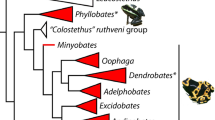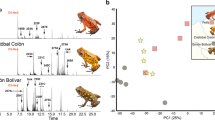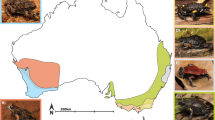Abstract
The strawberry poison frog Dendrobates pumilio (Anura: Dendrobatidae) and related poison frogs contain a variety of dendrobatid alkaloids that are considered to be sequestered through the consumption of alkaloid-containing arthropods microsympatrically distributed in the habitat. In addition to ants, beetles, and millipedes, we found that adults of two species of oribatid mites belonging to the cohort Brachypylina, trophically a lower level of animal than ants and beetles, contain dendrobatid alkaloids. Gas chromatography/mass spectrometry (GC/MS) of hexane extracts of adult Scheloribates azumaensis (Oribatida: Acari) revealed the presence of not only pumiliotoxin 251D (8-hydroxy-8-methyl-6-(2′-methylhexylidene)-1-azabicyclo[4.3.0]nonane), but also precoccinelline 193C and another coccinelline-type alkaloid. From the corresponding extracts of an unidentified Scheloribates sp., pumiliotoxin 237A (8-hydroxy-8-methyl-6-(2′-methylpentylidene)-1-azabicyclo[4.3.0]nonane) was detected as a minor component, and identified by synthesis. The presence of related alkaloids, namely deoxypumiliotoxin 193H, a 6,8-diethyl-5-propenylindolizidine, and tentatively, a 1-ethyl-4-pentenynylquinolizidine, were indicated by the GC/MS fragmentation patterns, along with at least another six unidentified alkaloid components. Thus, one possible origin of pumiliotoxins, coccinellid alkaloids, and certain izidines found in poison frogs may be mites of the genus Scheloribates and perhaps related genera in the suborder Oribatida.





Similar content being viewed by others
References
A. G. M. arrett F. Damiani (1999) ArticleTitleA formal synthesis of pumiliotoxin 251D, via a highly diastereoselective addition of a titanium homoenolate to an L-proline derivative J. Org. Chem. 64 1410–1411 Occurrence Handle10.1021/jo9820972
J. W. Daly R. J. Highet C. W. Myers (1984) ArticleTitleOccurrence of skin alkaloids in non-dendrobatid frogs from Brazil (Bufonidae), Australia (Myobatrachidae) and Madagascar (Mantellinae) Toxicon 22 905–919 Occurrence Handle10.1016/0041-0101(84)90182-X Occurrence Handle6523513
J. W. Daly C. W. Myers N. Whittaker (1987) ArticleTitleFurther classification of skin alkaloids from neotropical poison frogs (Dendrobatidae), with a general survey of toxic noxious substances in the Amphibia Toxicon 25 1023–1095 Occurrence Handle10.1016/0041-0101(87)90265-0 Occurrence Handle3321567
J. W. Daly S. I. Secunda H. M. Garraffo T. F. Spande A. Wisnieski J. F. Cover SuffixJr. (1994) ArticleTitleAn uptake system for dietary alkaloids in poison frogs (Dendrobatidae) Toxicon 32 657–663 Occurrence Handle10.1016/0041-0101(94)90335-2 Occurrence Handle7940573
J. W. Daly H. M. Garraffo T. F. Spande (1999) Alkaloids from amphibian skins S.W. Pelletier (Eds) Alkaloids: Chemical and Biological Perspectives, Vol. 13 Pergamon New York 1–161
J. W. Daly H. M. Garraffo P. Jain T. F. Spande R. R. Snelling C. Jaramillo A. S. Rand (2000) ArticleTitleArthropod–frog connection: decahydroquinoline and pyrrolizidine alkaloids common to microsympatric myrmicine ants and dendrobatid frogs J. Chem. Ecol. 26 73–85 Occurrence Handle10.1023/A:1005437427326
J. W. Daly T. Kaneko J. Wilham M. Garraffo T. F. Spande A. Espinosa M. A. Donnelly (2002) ArticleTitleBioactive alkaloids of frog skin: combinatorial bioprospecting reveals that pumiliotoxines have an arthropod source Proc. Natl. Acad. Sci. USA 99 13996–14001 Occurrence Handle10.1073/pnas.222551599 Occurrence Handle12381780
J. W. Daly H. M. Garraffo T. F. Spande V. C. Clark J. Y. Ma H. Ziffer J.F. Cover (2003) ArticleTitleEvidence for an enantioselective pumiliotoxin 7-hydroxylase in dendrobatid poison frogs of the genus Dendrobates Proc. Natl. Acad. Sci. USA 100 11092–11097 Occurrence Handle10.1073/pnas.1834430100 Occurrence Handle12960405
M. A. Donnelly (1991) ArticleTitleFeeding patterns of the strawberry poison frog, Dendrobates pumilio (Anura: Dendrobatidae) Copeia 199 723–730
J. P. Dumbacher A. Wako S. R. Derrickson A. Samuelson T. F. Spande J. W. Daly (2004) ArticleTitleMelyrid beetles (Choresine): a putative source for the batrachotoxin alkaloids found in poison-dart frogs and toxic passerine birds Proc. Natl. Acad. Sci. USA 101 15857–15861 Occurrence Handle10.1073/pnas.0407197101 Occurrence Handle15520388
Y. Enami Y. Nakamura H. Katsumata (1996) ArticleTitleA new species of the genus Scheloribates (Acari, Oribatei) from a crop field in Fukushima, North of Japan Edaphologia 56 11–16
D. N. A. Fox D. Lathbury M. F. Mahon K. C. Molloy T. Gallagher (1991) ArticleTitleEnantioselective synthesis of pumiliotoxin 251D. A strategy employing an allen-based electrophile-mediated cyclization J. Am. Chem. Soc. 113 2652–2656 Occurrence Handle10.1021/ja00007a044
H. M. Garraffo P. Jain T. F. Spande J. W. Daly (1997) ArticleTitleAlkaloid 223A: The first trisubstituted indolizidine from dendrobatid frogs J. Nat. Prod. 60 2–5 Occurrence Handle10.1021/np960522l Occurrence Handle9014346
M. Hammer (1958) ArticleTitleInvestigations on the oribatid fauna of the Andes mountains. I. The Argentine and Bolivia Biol. Skr. 10 1–129
M. Hammer (1967) ArticleTitleInvestigations on the oribatid fauna of New Zealand. Part II Biol. Skr. 15 1–64
P. Jain H. M. Garraffo T. F. Spande H. J. C. Yeh J. W. Daly (1995) ArticleTitleA new subclass of alkaloids from a dendrobatid poison frog: a structure for deoxypumiliotoxin 251H J. Nat. Prod. 58 100–104 Occurrence Handle10.1021/np50115a012 Occurrence Handle7760066
P. Jain H. M. Garraffo H. J. C. Yeh T. F. Spande J. W. Daly (1996) ArticleTitleA 1,4-disubstituted quinolizidine from a Madagascar mantelline frog (Mantella) J. Nat. Prod. 59 1174–1178 Occurrence Handle10.1021/np9605100 Occurrence Handle8988603
T. H. Jones J. S. T. Gorman R. R. Snelling J. H. C. Delabie M. S. Blum H.M. Garraffa P. Jain P. Jain J. W. Daly T. F. Spande (1999) ArticleTitleFurther alkaloids common to ants and frogs: decahydroquinolines and a quinolizidine J. Chem. Ecol. 25 1179–1193 Occurrence Handle10.1023/A:1020898229304
Y. Kuwahara (2004) Chemical ecology in astigmatid mites R. T. Cardé J.G. Millar (Eds) Advances in Chemical Ecology Cambridge University Press Cambridge 76–109
Y. Kuwahara H. Fukami S. Ishii K. Matsumoto Y. Wada (1980) ArticleTitlePheromone study on acarid mite. III. Citral: isolation and identification from four species of acarid mite, and its possible role Jpn. J. Sanit. Zool. 31 49–52
S. S. Lieberman (1986) ArticleTitleEcology of the leaf litter herpetofauna of a neotropical rain forest: La Selva Costa Rica Acta Zool. Mex. 15 1–72
K. Masuko (1994) ArticleTitleSpecialized predation on oribatid mites by two species of the ant genus Myrmecina (Hymenoptera: Formicidae) Psyche 101 159–173
M. R. Mortari E. N. Ferroni Schwartz C. A. Schwarz O. Rodrigues Pieres SuffixJr. M. MoreiraSantos C. Bloch SuffixJr. A. Seben (2004) ArticleTitleMain alkaloids from the Brazilian dendrobatidae frog: Epipedobates flavopictus: pumiliotoxin 251D, histrionicotoxin and decahydroquinolines Toxicon 43 303–310 Occurrence Handle10.1016/j.toxicon.2004.01.001 Occurrence Handle15033329
G. Raspotnig R. Schuster G. Krisper G. Fauler H.-J. Leis (2001) ArticleTitleChemistry of oil gland secretion of Collohmannia gigantea (Acari: Oribatida) Exp. Appl. Acarol. 25 933–946 Occurrence Handle10.1023/A:1020634215709 Occurrence Handle12465848
G. Raspotnig G. Krisper R. Schuster (2005a) ArticleTitleOntogenetic changes in the chemistry and morphology of oil glands in Hermannia convexa (Acari: Oribatida) Exp. Appl. Acarol. 35 47–58 Occurrence Handle10.1007/s10493-004-2027-z
G. Raspotnig G. Krisper R. Schuster G. Fauler H.-J. Leis (2005) ArticleTitleVolatile exudates from the oribatid mite, Platynothrus peltifer J. Chem. Ecol. 31 419–430 Occurrence Handle10.1007/s10886-005-1350-0 Occurrence Handle15856793
T. Sakata Y. Kuwahara (2001) ArticleTitleStructure elucidation and synthesis of 3-hydroxybenzene-1,2-dicarbaldehyde from astigmatid mites Biosci. Biotechnol. Biochem. 65 2315–2317 Occurrence Handle10.1271/bbb.65.2315 Occurrence Handle11758930
T. Sakata R. A. Norton (2001) ArticleTitleOpisthonotal gland chemistry of early derivative oribatid mites (Acari) and its relevance to systemic relationships of Astigmata Int. J. Acarol. 27 281–292
T. Sakata K. Tagami Y. Kuwahara (1995) ArticleTitleChemical ecology of oribatid mites: I. Oil gland components of Hydronothrus crispus Aoki J. Acarol. Soc. Jpn. 4 69–75
T. Sakata N. Hiramatsu K. Ishikawa Y. Kuwahara (1997) ArticleTitleChemical ecology of mesostigmatid mites: I. Identification of hydroxymethylnaphthoquinones from Uroactinia hirschmanni Hiramatsu (Mesostigmata: Uropodidae) Appl. Entomol. Zool. 32 57–61
T. Sakata S. Shimano Y. Kuwahara (2003) ArticleTitleChemical ecology of oribatid mites: III. Chemical composition of oil gland exudate from two oribatid mites, Trhypochthoniellus sp. and Trhypochthonius japonicus (Acari: Trhypochthoniidae) Exp. Appl. Acarol. 29 279–291 Occurrence Handle10.1023/A:1025882214375 Occurrence Handle14635814
L. S. Santos R. A. Pilli (2001) ArticleTitleTotal synthesis of (±)-homopumiliotoxin 223G Tetrahedron Lett. 42 6999–7001 Occurrence Handle10.1016/S0040-4039(01)01389-2
J. C. Santos L. A. Coloma D. C. Cannatella (2003) ArticleTitleMultiple, recurring origins of aposematism and diet specialization in poison frogs (Dendrobatidae) Proc. Natl. Acad. Sci. U. S. A. 100 12792–12797 Occurrence Handle10.1073/pnas.2133521100 Occurrence Handle14555763
R. A. Saporito H. M. Garraffo M. A. Donnelly A. L. Edwards J. T. Longino J. W. Daly (2004) ArticleTitleFormicine ants: an arthropod source for the pumiliotoxin alkaloids of dendrobatid poison frogs Proc. Natl. Acad. Sci. U. S. A. 101 8045–8050 Occurrence Handle10.1073/pnas.0402365101 Occurrence Handle15128938
S. Shimano T. Sakata Y. Mizutani Y. Kuwahara J. Aoki (2002) ArticleTitleGeranial: the alarm pheromone in the nymphal stage of oribatid mite, Nothrus palustris (C. L. Koch) (Oribatida: Nothridae) J. Chem. Ecol. 28 1831–1837 Occurrence Handle10.1023/A:1020517319363 Occurrence Handle12449509
K. Summers (2003) ArticleTitleConvergent evolution of bright coloration and toxicity in frogs Proc. Natl. Acad. Sci. 100 12533–12534 Occurrence Handle10.1073/pnas.2335928100 Occurrence Handle14569014
K. Summers M. E. Clough (2001) ArticleTitleThe evolution of coloration and toxicity in the poison frog family (Dendrobatidae) Proc. Natl. Acad. Sci. U. S. A. 98 6227–6232 Occurrence Handle10.1073/pnas.101134898 Occurrence Handle11353830
N. Toyooka A. Fukutome H. Nemoto J. W. Daly T. F. Spande H. M. Garraffo T. Kaneko (2002) ArticleTitleSynthesis of alkaloid 223A and a structural revision Org. Lett. 4 1715–1717 Occurrence Handle10.1021/ol025775m Occurrence Handle12000281
M. Vences C. Kniel (1998) ArticleTitleMikrophage und Myrmecophage Ernäherungsspezialisierung bei Madagassichen Giftfroschen der Gattung Mantella Salamandra 34 245–254
M. Vences F. Glaw W. Bolme (1998) ArticleTitleEvolutionary correlates of microphage in alkaloid-containing frogs (Amphibia: Anura) Zool. Anzeig. 236 217–230
M. Vences J. Kosuch R. Boistel C. F. B. Haddad E. Marca S. Lotters M. Veith (2003) ArticleTitleConvergent evolution of aposematic coloration in neotropical poison frogs: a molecular phylogenetic perspective Org. Divers. Evol. 3 215–226 Occurrence Handle10.1078/1439-6092-00076
Acknowledgments
We are grateful to Dr. H. Katsumata (Yokohama Plant Protection Station, Ministry of Agriculture, Forestry and Fisheries, Yokohama, 231-0801 Japan) for measuring the body size of the S. azumaensis tritonymph. We also thank reviewers of this manuscript for their valuable comments. This study was partly supported by a Grant-in-Aid for Scientific Research (no.15580090) and the 21st century COE program for Innovative Food and Environmental Studies Pioneered by Entomomimetic Sciences, from the Ministry of Education, Culture, Sports, Science and Technology of Japan.
Author information
Authors and Affiliations
Corresponding author
Additional information
Chemical Ecology of Oribatid Mites IV.
Rights and permissions
About this article
Cite this article
Takada, W., Sakata, T., Shimano, S. et al. Scheloribatid Mites as the Source of Pumiliotoxins in Dendrobatid Frogs†. J Chem Ecol 31, 2403–2415 (2005). https://doi.org/10.1007/s10886-005-7109-9
Received:
Revised:
Accepted:
Published:
Issue Date:
DOI: https://doi.org/10.1007/s10886-005-7109-9




